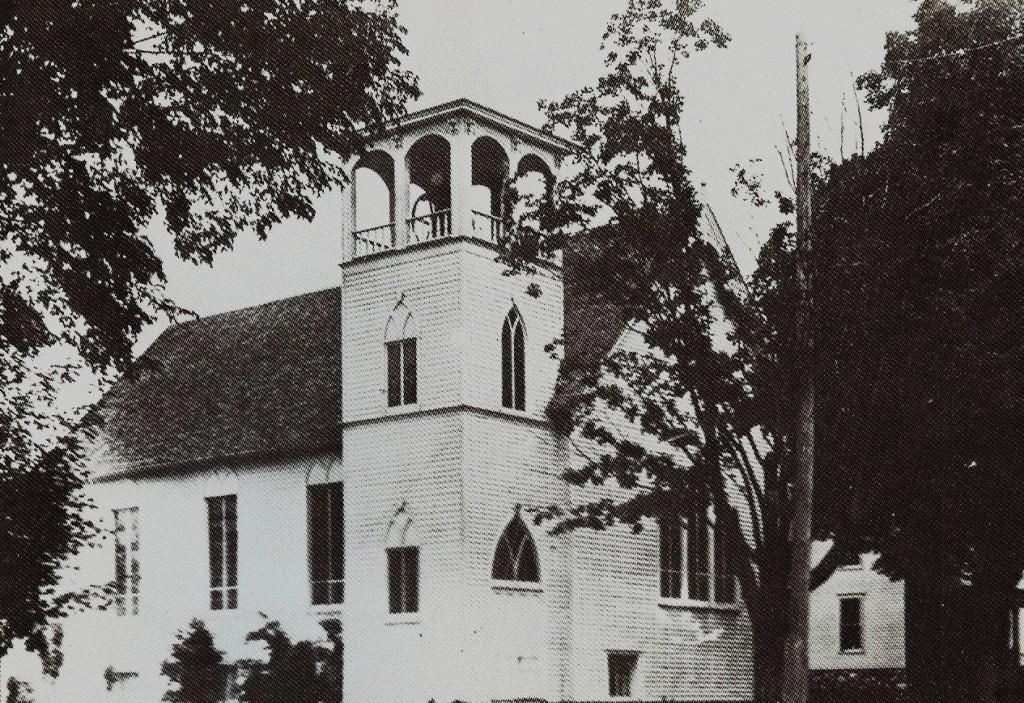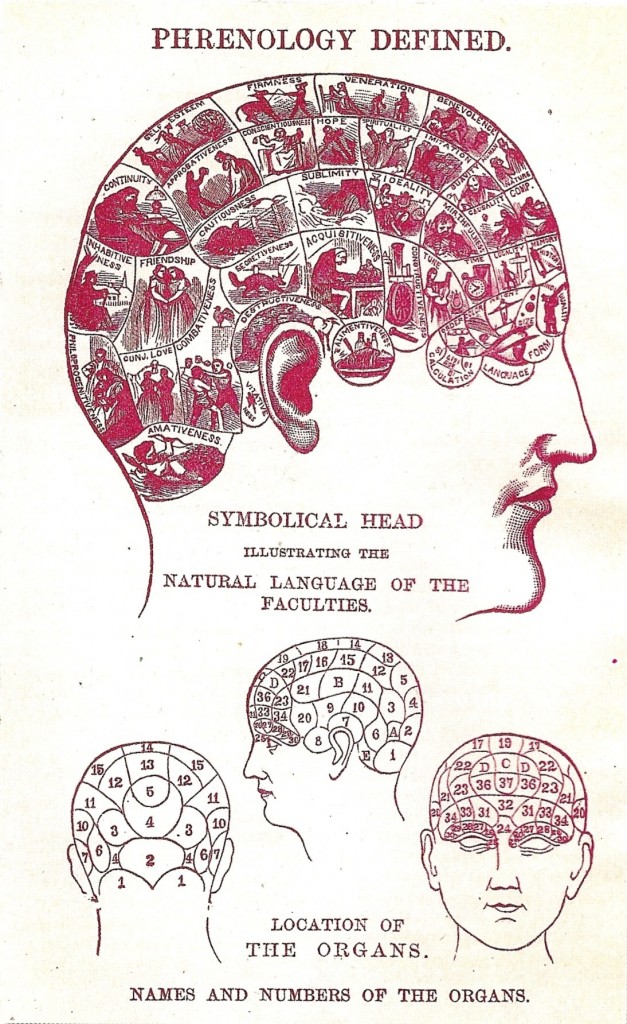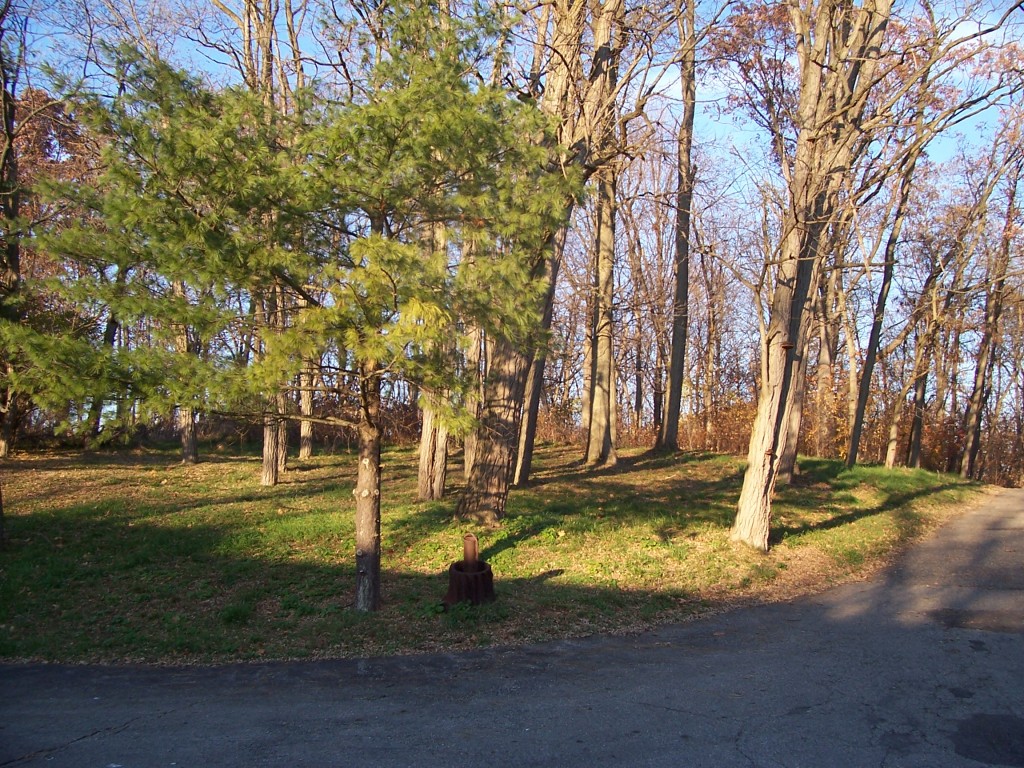Phrenology and Ghosts in Manchester, Part One of Two
by Ray Berg and Alan Dyer
Early Manchester Adult Education
Small towns on the western frontier in the 1840s hungered for the latest educational, social, and literary developments, particularly by those residents who had come from the larger cities in New York. Manchester was no exception. This hunger was largely fed by touring lecturers, and by local societies such as the Manchester Lyceum which was established in November 1836. The Lyceum movement was particularly influenced by the development of the Erie Canal and the railroad, which allowed noted lecturers and entertainers to easily travel from city to city. After the Civil War, lyceums evolved into the Chautauqua Movement and vaudevilles, and became more entertainment in nature and elaborate. Manchester also formed organizations such as the Manchester Clay Club in 1840, to attract followers to and promote Henry Clay, the Whig Party and its principles.
One of these noted lecturers who made several visits to Manchester in this period was a “Dr. B. A. Parnell.” Students of Manchester’s early history may be familiar with two publications: Annetta English’s 1930 “History of Manchester Township” and Jane Palmer’s 1964 “History of Manchester, Michigan”. While referencing these works for a story on Manchester’s Old Burying Ground, the authors noted that both of these histories contained a similar story regarding this Dr. Parnell who came to town in 1847.
From English’s History, page 58: “A select school was kept for years in the [Presbyterian] church basement. The church bell, now in the tower of the Roman Catholic church, was purchased by personal gifts of money added to a fund received from the proceeds of a lecture delivered by a Mr. Parnell in the basement of the church. He was to give a second lecture, but was taken ill after the first lecture was over, and died following a severe hemorrhage of the lungs. He asked that his brain be sent to Fowler and Wells, New York City, noted phrenologists, and the village physicians, Dr. Wm. H. Bessac, and Drs. Bennett and William Root, performed an autopsy. He was buried at his request, with his feet toward the South (for he was an ardent anti-slavery lecturer), in the old cemetery in the North Bend of the Raisin River. This was about 1850 or later. The spot, where he rests, is no longer discernible, for no stone was erected and the wooden picket fence about the lot soon rotted away.”
From Palmer’s History, page 123: “The church bell was secured by a personal subscription, and proceeds of a lecture by a Mr. Parnell, noted antislavery lecturer, were donated.”
The authors were intrigued by this story and decided to pursue it using modern research tools (particularly Google Books), and the resources of the Bentley Historical Library at the University of Michigan. Our initial questions were: Who was Dr. Parnell? Why was his brain sent to New York City? Why was he buried in Manchester, and apparently forgotten in the old cemetery? Is there more to this story?
First Steps
Google Books is an amazing tool. By entering “Parnell” and “Manchester”, we were immediately taken to a fully digitized copy of the 1847 publication: “The American Phrenological Journal and Miscellany”, Volume IX, edited by Orson S. Fowler. On page 211, we found a letter to Fowler from Calvin S. Townsend, a prominent Manchester resident, attorney and phrenologist. He lived in Manchester in 1837-1859 before moving to Rochester, N. Y. An excerpt follows:
Manchester, Washtenaw Co., Michigan, May 1, 1847“Gentlemen:—I write for the purpose of announcing to your readers the sudden death of B. A. Parnell! He was a man very universally known throughout the western and southwestern States, as a popular lecturer and indefatigable laborer in the field of phrenological science. Few men have done as much in that particular department of labor, and fewer still have been as successful in convincing their fellow men of the truth of the great leading features of the interesting science to which his life was chiefly devoted. He died at the "Manchester Hotel," in this village, on Thursday, the 22d day of April, at 20 minutes before 12 o'clock (noon), of hemorrhage of the stomach. He visited our village on Monday the 5th of April, for the purpose of delivering to our citizens a course of lectures upon a variety of subjects; and has lectured thereafter, for fifteen successive week-day evenings, to crowded and attentive audiences. His health had been feeble for the last nine or ten months immediately preceding his death; but still, with an energy and zeal which knew no obstacles too formidable to be vanquished, he continued to labor. His time, attention, and commanding talents have been devoted to the investigation and dissemination of the principles of the science of Phrenology for the last sixteen or eighteen years. He has Lectured almost incessantly ; and it is to be regretted that he lectured so Much, and wrote so Little : for had his observation and experience been placed on record, the hundreds of thousands who have been delighted with his instructions might still have continued to take lessons from their teacher. But Oral instruction seemed to be his Forte. He was a ready, captivating, and persuasive speaker.
…About two weeks before his last and fatal attack, being confident that his days were few, he made the singular request, and often repeated and insisted upon it, that he should be buried North and South, with his feet directed to the South, and that the writer should take his head from his body, and secure its perpetual safe preservation. His first wish has been complied with; he is buried in our village grave-yard with his feet to the South; and I have his head in my possession, and have adopted such measures as cannot fail to secure it. He often said that the contemplation of the human head had been a matter of great and absorbing interest with him for many years, and he could not bear the thought that His should become food for worms.”
The remainder of the letter provided a detailed listing of Dr. Parnell’s strengths and weaknesses, written from a phrenologist’s point of view as if Parnell’s head had been examined.
That Dr. B. A. Parnell died in Manchester, was buried in the Old Burying Ground, and his head removed and preserved was a given at this point. That his primary fame was as a phrenologist, not an anti-slavery lecturer, also seemed evident. But many other questions were left unanswered. What additional information about the man existed? What exactly is phrenology, and what role did it play in the mid-nineteenth century? And who were Fowler and Wells mentioned by Annetta English in her History?
Figure 1 – The original Presbyterian Church in Manchester, and subsequently both a Methodist and Baptist church, currently housing offices at 122 W. Main – site of Dr. B. A. Parnell’s lectures in 1847
What is Phrenology?
Phrenology is the study of the structure of the skull, to determine a person's character and mental capabilities. It originated in the late 18th century with a Viennese physician named Franz Joseph Gall, who postulated that the mind is composed of several distinct, innate faculties, with separate seats or "organs" within the brain. The size of an organ, other things being equal, is a measure of its power, with the shape of the brain determined by the development of the various organs. Since the skull was believed to conform and take its shape from the brain, its surface was considered an accurate index of psychological aptitudes and tendencies. By examining the shape and unevenness of a head or skull, one could discover the development of different intellectual aptitudes and character traits.
Phrenology became a rapidly growing “science” in the United States in the 1820s and 1830s, and persisted into the first decades of the 20th century. It was a common practice for traveling phrenologists to give lectures and conduct examinations in small towns as part of an “educational” tour. A phrenological exam involved running the fingertips and palms over the skulls of patients to feel for enlargements or indentations. The phrenologist would usually take measurements of the overall head size using a caliper. With this information, the phrenologist could assess the character and temperament of the patient, and address each of the 27 "brain organs" in which specific attributes were centered. This type of analysis was often used to predict a child's future, determine university admissions, assess prospective marriage partners, and provide background checks for job applicants.
In the Victorian age, phrenology, as a forerunner of psychology, was taken seriously and permeated the literature and novels of the day. Many prominent public figures actively promoted it as a source of psychological insight and self-knowledge. Consequently, the idea of phrenology as a science waned and became more closely associated with the popular psychology of the day. It can be compared to psychoanalysis which would influence social thought and relationships a century later. Beginning in the 1840s, phrenology in North America also became part of a counter-culture movement evident in the appearance of new dress styles, communes, mesmerism, and a revival of the use of herbal remedies.
Figure 2 – A Phrenological Illustration of a Person’s Innate Mental Organs, by Orson Fowler
Back to Dr. Parnell
Internet research provided an extensive listing of Dr. Parnell’s appearances and the accolades that followed him throughout the Midwest during the 1830s and 1840s. In addition to this regional recognition, he received support from national phrenologists such as Fowler & Wells. So great was his esteem as a lecturer that he addressed Ohio’s House of Representatives in 1842.
As noted during his Ohio visit: “Dr. Parnell has been lecturing, for several evenings, to crowded houses, on the science of Phrenology. Last evening, he was blindfolded, and requested to examine the head of a distinguished citizen, whom, though entirely unknown to him, he described, it is said, ‘to the life’. Phrenology ain't dead yet. Better come to us, and buy some of O. S. Fowler's books, the cheapest and best practical work.”
In 1835, he lectured in Quebec at a large St. Patrick’s Day gathering, where, “having examined and turned all the heads before and being present at said dinner”, he was toasted to the tune of the popular children’s song of the time “The Hunting of Hare”:
Oh what science can compare To the one that through our hair, Can by feeling, can by feeling, Tell the feelings that must guide us: To Phrenology I've turned, And I sing of what I've learned From Parnell,— Dr. Parnell,— Who's a monstrous clever fellow, Clever fellow.
This song went on to achieve widespread popularity throughout North America.
Another Michigan believer in phrenology wrote: “We had the pleasure, during the winter of '39, of hearing that prince of phrenologists, Dr. B. A. Parnell of Maine, lecture. He was an able and eloquent lecturer, and was not only the first who introduced that would-be science to the people of Battle Creek, but he was the best, not excepting the Fowlers. He was a Webster, not only in physique and personal appearance, but in intellectual and oratorical powers as well. He was the great expounder of phrenology, and gave it more prominence with the general public where he lectured than any other advocate of that new science during his day.”
The authors found dozens of glowing references to Dr. Parnell’s work in Michigan and the Midwest. All records refer to him simply as “Dr. B. A. Parnell”, never identifying his first name or any other biographical information about him. It took considerable research in early editions of the Ann Arbor Argus to locate his first name. Early newspapers in Washtenaw County would identify mail being held at the post office for pickup by the addressee, and it was here that several references to mail waiting for Dr. Buckley A. Parnell were found. Land purchase records for Buckley A. Parnell in the 1830s were also found in Ionia and Van Buren Counties. We surmise that he felt his given birth name was not dignified or appropriate to a man of his education or beliefs in those times, so he simply stopped using it.
There are no known records of his parents, early life, his age, any marriage or any other biographical information on Dr. Parnell. Census records prior to 1850 list only the head of the household, and he has not been found in any census data. One admirer referred to him as coming from Maine, but that is the only detail we have. Dr. Parnell apparently was a true “road warrior” who had no permanent home. Instead, he lived an unencumbered life, traveling from town to town giving lectures for 15-20 years, subsisting on speaking fees and the generosity of patrons along the way.
The True Democrat (Ann Arbor), May 4, 1847, reprinted an obituary originally appearing in the Marshall Expounder. It repeated much of what Calvin Townsend wrote as described above, adding that, even in ill health, Parnell agreed to a lecture, the proceeds of which would be devoted to the purchase of a bell for one of our village churches. The remainder of the obituary includes a very graphic description of his last hours. The funeral was attended by all the clergymen of Manchester village, plus a large audience of townspeople. Rev. Taylor of the Presbyterian Church preached an impressive discourse from Psalms 90th, 3rd verse. Parnell’s burial, which was carried out in accordance with his requests, was in the most beautiful part of the graveyard; a high steep bank overlooking the river, i.e., on the northwest corner of the grounds near Washington Street. The obituary concluded with a plea to Mr. Parnell’s friends in Marshall to help provide a suitable monument to mark his final resting place. This was not done, and Parnell’s grave was eventually lost among the other 75-100 Manchester pioneers still resting in the Old Burying Ground.
Click HERE to read part 2!
Figure 3 – Manchester’s Old Burying Ground on Washington Street. Dr. Parnell’s grave is at the high point of the cemetery, overlooking the River Raisin.











You must be logged in to post a comment Login